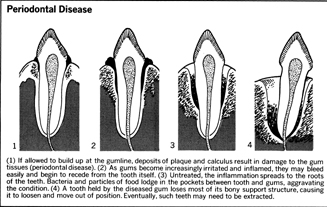Periodontal Disease - The course of the disease
The Course of the Disease
Periodontal disease is an infection of the tissues surrounding and supporting the teeth. This includes the gums (gingiva), connective tissue (periodontal ligament), and tooth sockets (alveolar bone). It is caused by plaque, a sticky, colorless film of bacteria that constantly forms on the teeth. If plaque isn't removed each day by brushing and flossing, it hardens and turns into tartar, or calculus. The toxins (poisons) produced by the bacteria in plaque and tartar irritate the gums.
Gingivitis , an inflammation of the gums, is the mildest form of periodontal disease. At first there is a slight redness and swelling of the gum tissue around one or more teeth. Later the redness and swelling become more pronounced and the gums tend to bleed easily. Bleeding that occurs during flossing or toothbrushing is one of the earliest signs of periodontal disease. Gingivitis is reversible with professional treatment and with good home oral care.
Periodontitis , also called pyorrhea , is an advanced stage of gum disease. Symptoms include persistent bad breath; receding and shrinking gums; loose or separating teeth; a hypersensitivity to hot, cold, or sweet foods or beverages; and a change in the way your teeth fit together when you bite.
Periodontitis occurs when plaque and tartar extend below the gum line. The gums separate from the teeth, forming pockets that fill up with more plaque and bacteria. As the disease progresses, the bacteria weakens the bone supporting the teeth and the affected teeth begin to loosen and drift from their normal position. Finally, if the disease is left untreated, the teeth may be lost.
Another form of periodontal disease is an acute infection called trench mouth . It is also known as necrotizing gingivitis or Vincent's infection . The condition is very painful and is characterized by profuse bleeding at the slightest pressure or irritation. The affected areas become inflamed and develop blisters. A grayish-yellow membrane covers the infected areas and unpleasant breath odor is usually present. Other parts of the mouth, such as the insides of the cheeks and the tonsils, sometimes become infected. The disease was given the name trench mouth during World War I, when soldiers living in trenches contracted the disease. The infection is associated with poor oral hygiene and poor nutrition.


Comment about this article, ask questions, or add new information about this topic: